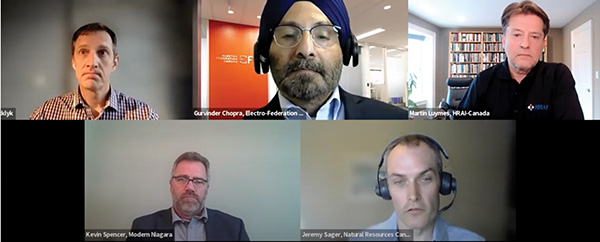
Road to 2030: A Panel Discussion
May 31, 2022 | By Doug Picklyk
We gathered four industry professionals together to share ideas on how trade contractors can get on board and get ahead of the federal emissions reduction plans.

Across Canada buildings of all sizes account for 12% of the greenhouse gas (GHG) emissions released into the atmosphere. As a category, the emissions generated by constructing and then burning fuel to heat homes and office towers are behind only the oil & gas (26%) and transportation (25%) sectors as the most prolific polluters in the country, and that’s why programs are being drafted to encourage change.
This past March the federal government released its 2030 Emissions Reduction Plan, a 271-page document that includes $9.1 billion in new investments designed to ensure Canada will reach an emissions reduction target of 40 to 45% below our 2005 levels by 2030. This target is designed to put the country on a path towards achieving net zero emissions by 2050—a commitment made by countries around the world as part of the Paris Agreement.
Among the spending announced in the new 2030 Plan is $150 million towards the Canada Green Buildings Strategy, a nation-wide game plan to develop new policy incentives and standards to drive new building construction and the retrofits of existing building stock towards zero carbon standards.
According to Kevin Spencer, vice president of energy solutions with Modern Niagara, a national mechanical and electrical commercial contracting company, the demand for decarbonization among new building projects has already started.
“Especially for government projects, there is certainly a focus on GHG targets that must be met by the team that’s designing and building the facility, and it has to operate that way as well,” said Spencer during a panel discussion with three other industry experts hosted by HPAC and Electrical Business magazines.
Held on April 25th, the live online panel event, The Road to 2030: Trades Contractors and the Federal 2030 Emissions Reduction Plan, was sponsored by Eaton and Mitsubishi Electric Heating and Cooling.
The hour-long event addressed what mechanical and electrical contractors need to know and how they can get out ahead of changes that are coming to the building industry.

The virtual Road to 2030 round-table discussion included: (clockwise from top left) Doug Picklyk, HPAC; Gurvinder Chopra, Electro-Federation Canada; Martin Luymes, HRAI; Jeremy Sager, Canmet ENERGY; and Kevin Spencer, Modern Niagara.
When it comes to retrofits of commercial buildings, Spencer is seeing two different approaches among existing building owners. There are companies that have articulated their own climate reduction goals and have started down the emissions reduction path, and then there are the building owners who are in a wait-and-see mode.
“We have an energy solutions group with a number of energy engineers and HVAC technicians that are looking for better ways to improve not just the energy efficiency of buildings, but now we’re also switching over to help our clients decarbonize and electrify,” says Spencer.
And while he’s seeing progressive companies that are in the planning stages, he foresees the actual transition to lower-emissions technology will begin happening between now and 2030.
For residential contractors, the most significant push towards decarbonizing homes is the transition off of natural gas and towards electric heat pump technology for heating and cooling —a solution that’s being heavily promoted in jurisdictions across Canada.
Jeremy Sager, a senior HVAC and renewables research engineer with CanmetENERGY (NRCan), addressed some obstacles that contractors need to be aware of to get themselves and homeowners on board with electrification.
“We need to get past the assumption that heat pumps don’t work in cold climates,” says Sager. “We’ve done testing on this technology in our lab … and we’ve seen that the systems do perform well, even in cold temperatures, some systems performed down to -30 Celsius.”
A range of heat pump technologies exist today, and Sager explains that there are options for those who want to fully electrify their homes or those looking to begin with a dual fuel, or hybrid system, by adding a heat pump to an existing gas furnace, or even those with electric baseboards who could incorporate heat pumps to displace some of their loads with more efficient heat pump solutions.
A challenge he sees is contractors not taking the time to properly size and select systems. “I think calculating proper design, including a heat loss and heat gain calculation, is something that needs to be done to make sure we’re getting the systems in the right size to address the load. We don’t want to oversize, and we don’t want to undersize,” says Sager.
While he sees heat gain/loss calculations being more common for new builds, it’s not always built into retrofit projects and that’s a problem.
Industry Acceptance
Martin Luymes, vice president of government and stakeholder relations for the Heating Refrigeration and Air Conditioning Institute of Canada (HRAI), is seeing a range of attitudes among members when it comes to transitioning heating and cooling away from fossil fuels. “Among the contractors, it’s a very small percentage of people who are very eager to get into this, but on the other hand, we have people who remain skeptical.”
Industry veterans have experienced government commitments and then withdrawals from low carbon programs and policies in the past. “That creates a bit of an uncertainty around where we’re going, and for contractors to invest in the future of their businesses in terms of product mix and train employees requires clear signals from government,” says Luymes.
“However, I will say, I think more and more our membership is getting the sense that this is an inevitability and they need to start preparing.”
Some concerns about decarbonization and a mass migration to all-electric solutions for heating buildings revolve around the additional load being placed on our existing and aging electrical grid.
Canada’s electricity grid is one of the cleanest in the world, with over 80% produced by non-emitting sources, and part of the 2030 Plan includes transitioning the remaining generation to clean sources. And although there are other “clean” alternatives for heating, such as hydrogen and biomass as alternative fuel sources, electricity is the leading solution.

Gurvinder Chopra, Electro-Fed
“When it comes to clean energy, or reducing carbon emissions, electricity has and will play an important role in achieving those goals,” says Gurvinder Chopra, vice-president standards and regulations with Electro-Federation Canada. “Our research and development teams are spearheading their product designs in that direction.”
Electrical grids and electrical products are all going through a transformation as technology and innovation are disrupting the traditional models, notes Chopra, who points to three key trends leading the disruption:
- the electrification of the transportation sector;
- decentralization or distributed energy resources (DERs), where localized energy generation and storage meet demand flexibility and energy efficiency;
- and the digitalization of the grid including smart metering, smart sensors and automation beyond the meter.
With respect to concerns about grid capacity, Chopra explains that it is clear from many studies that unless there is a very sudden upsurge, the current power system is capable of absorbing additional loads. He does acknowledge there is a need for investments and operational adjustments including replacing aging, inefficient electrical infrastructure, and using energy efficient products.
Retrofit Opportunity
The transition of buildings away from fossil fuels to electrification for heating and cooling does provide a “massive opportunity” for contractors, suggests Spencer.
And although he admits the government messaging with respect to incentives doesn’t seem to be uniform across the across the country right now, he is confident that the traditional course of action for lifecycle replacement—swapping out fuel-burning equipment for the same thing—is going to be disrupted.
Sager also sees a huge opportunity on the residential side with air conditioner replacements. “Let’s look for ways to swap out [the AC unit] for an equivalent capacity heat pump, if that’s what the homeowner is looking for,” he says.
“Our research has shown that if you do go this route, you can still generate 25 to 30% GHG reductions if you swap an air conditioner with a like-for-like heat pump.
“I think the more we can get heat pumps into people’s houses the more costs are going to come down and the more heat pumps going to become a commoditized item, like a furnace is for the average homeowner now.”
Jeremy Sager, NRCan
Contractors can also offer solutions to homeowners that can optimize their heating systems to be lower cost or to release fewer GHG emissions.
In jurisdictions like Ontario, where there is time-of-use electricity pricing, smart switching controls can be incorporated with the use of hybrid (or dual-fuel) heating systems—using an electric heat pump in tandem with a gas-fueled furnace—and the controls will ensure the homeowner is operating the least-cost heating system at all times.
“I would encourage contractors and distributors to ask for these kinds of capabilities from their equipment suppliers,” says Sager, who also suggests making homeowners more aware of ground source heat pump systems as well as the air source heat pump options.
Taking Charge
As different levels of government continue to develop new plans and directives to drive Canadians towards new emission-free ways to heat and cool homes, both Luymes and Chopra agree that industry needs to be at the table helping to set the agenda.
“One of the things we need to do as a sector across the board, is to send a signal to utilities and governments at the provincial, federal and even municipal level that we have solutions, we have ideas about leading the way in the drive to low carbon technologies.”
Martin Luymes, HRAI
For example, HRAI conducted research that shows that a greater adoption of ground source heat pumps, rather than relying 100% on air source heat pumps, could provide great benefits to managing the grid because the ground source systems don’t peak anywhere close to the same level on the coldest days of the year.
Luymes points to this research being helpful to the electrification policy discussion. “It doesn’t really say one technology is better than the other—it’s more about showing there are considerations that need to be thought through when we’re talking about electrification.”
According to Chopra, almost every member of Electro-Federation is aligning with climate change. “I mean, they have to be, there’s no other option. They’re all helping the customers and suppliers to implement sustainable practices across the value chain and throughout the lifecycle of their products and solutions.”
He also highlighted one member company that has supported two apartment buildings in Switzerland with carbon neutral energy production and with no-cost electricity or heating for the tenants with photovoltaic modules installed on the front and on the roofs, and with two wind turbines.
“The production covers energy demand for heating and cooling, and the production of hot water for all residents. The system also manages switching from one source to another at optimal times, switching power on and off to manage efficiencies and costs. So, all this is happening as we speak, and as Martin mentioned, we need to have proper policies in place which would help these going forward.”
Selling the Life Cycle
The panelists all agreed that where the greatest gap exists in the industry today is in the number of properly-trained technicians and the lack of long-term thinking when it comes to selling HVAC systems.
“When you’re dealing with a building owner, and whether it’s HVAC equipment or whatever it may be, the focus is typically always on installed price,” says Spencer. “And yet there’s so much more that goes into it—there’s the energy consumption and the air tightness of the building—and it doesn’t really matter if it’s a residential building or a commercial building, but we really are lacking the skilled expertise to look at a building, and the systems in that building, and come up with solutions for that client where we can say:
‘Here’s what the financial cost over the lifecycle of that equipment will look like for you. Today, if you put in a heat pump, whether it’s ground source or air source, it will absolutely over its lifecycle be more cost effective than fossil fuel based natural gas.’”
He sees the selling process today to be too short-sighted. People are replacing gas appliances for similar products because it’s familiar.
Kevin Spencer, Modern Niagara
“Carbon pricing is escalating, so when you look out even eight years from now pricing will change. So now is the time to be presenting other options with longer-term benefits for clients.”
Selling against the rising carbon price is seen as a short-coming for the industry. “If you’re not thinking about that, and presenting the alternatives to your customers, you’re really doing a disservice,” suggests Luymes.
HRAI has been working on a plan of training programs for a low carbon future. It includes re-training programs for existing HVAC technicians as well as developing a new pathway to attract new technicians for the residential heat pump trade.
But by far the biggest need, says Luymes, is to get people to understand how to sell the solutions. “There’s all kinds of new technologies and people have to technically understand how to install and service them, but also, how do you sell them, particularly when the price point is a bit higher than what people are used to?”
Sager and Luymes also see opportunity in the market for existing contractors to join forces to provide a broader suite of services to address energy retrofit solutions for businesses and homeowners.
HVAC contractors can take the lead on the mechanical room, while electricians manage solar solutions and smart controls, while another contractor takes care of the windows, insulation, weather stripping etc. Very few companies are in a position to offer the whole suite of services and that could create a new business model.
“And I would suggest that contractors who think about leading with their own expertise and broaden into some of those other services will be doing themselves a favour,” says Luymes. “They’ll also be doing their customers a favour and will be positioning themselves for long term success.” <>
Here is a recording of the entire Road to 2030 session.







